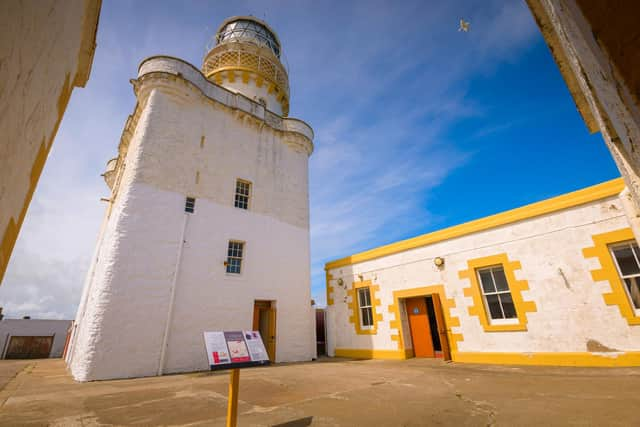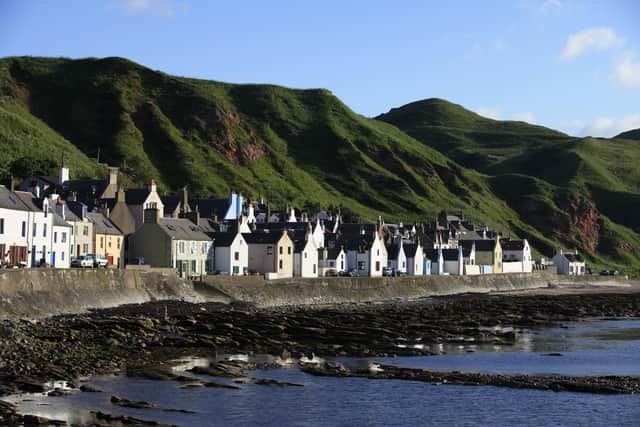Road trip plan: tour Scotland’s #NE250 route


After leaving the busy town of Peterhead and its deep connection to the sea behind, it was time to briefly head off route to the inland.
Venturing away from the coast, the Shire’s lush and ample agricultural lands unfold as winding roads meander and out-of-the-way villages emerge. It’s a part of the world that quietly ticks away without ceremony – and still feels relatively untouched by much.
Just outside Mintlaw, the Saplinbrae House Hotel is a fine retreat on the road less travelled. It feels both grand and relaxed, unfussy and yet quality. Built in the mid 18th Century as a coach house, a deep sleep was found in a gorgeous four poster bed in a supremely comfortable room that was hard to leave. Dinner, too, was exceptional and well thought out on a proud foundation of local produce, with the pork and roast rhubarb a most memorable dish.
Greek temples and alligators
After dinner, and as the midsummer sun poked out from the parting rainclouds, a small walk was in order. Edging further in the estate and Pitfour Lake unexpectedly appears through the trees. The place has a magical touch about it and by the still water’s edge stands a little Greek-style temple, where it is said one of the later lairds kept his alligators. Pitfour House has long vanished from the landscape but what remains indicates how the wealthy favoured this pocket of deep country, and you can see why given its hidden, secret feel.
This is also true of nearby Deer Abbey, which sits just a moment from the Saplinbrae. What remains is now a mere footprint of the mighty Cistercian abbey that stood here for more than 300 years, until the Reformation. It’s possible this was also once home to an earlier Pictish abbey, where the Book of Deer was written around 900 AD and which contains the oldest examples of written Gaelic in Scotland. Both the book and place are an enigmatic manifestation of crossing timelines and cultures. Back in time, this site heaved with religious activity but today it rests fully at peace, only the breeze and birdlife playing on the silence.
Shipwrecks and lighthouse lore


From deep country, the sea calls once more as the North East 250 continues.
At the fishing town of Fraserburgh there is an unexpected treasure at the Museum of Scottish Lighthouses, where the powerful story of how man and water have often dangerously co-existed is expertly told.
Kinnaird Head Castle Lighthouse is the oldest in the UK and on a tour you will step inside this incredible building, which was originally a castle built for the Fraser family in the 1500s.
In the late 1700s, as shipwrecks started to litter the shore and concerns were raised over loss of valuable cargo, a new safety system was required and fixed the first oil lights to the castle wall, with the Stevenson family later returning to build a lighthouse through the original castle.


What stands today is testament to the engineering genius propagated by the Stevenson lighthouse builders, the smell of oil guiding the way up the tight staircase to see the lamp and its mechanism, which are still in pristine condition. An excellent tour brings the way of life of the lighthouse keepers to life, with their accommodation found in much the same way as it was left back in 1991 when the lamp was lit manually for the last time.
As the road east out of Fraserburgh beckons, so does the Moray coast.
Local Hero
It’s hard to resist not coming off the main drag onto the B9301, the road that leads you towards the little villages of Pennan, made famous by the film Local Hero and its red phonebox, and Gardenstown. Both are now fragile communities and the roads really are not designed for an influx of cars. It would be better to venture down into Gardenstown on foot to experience the tight little streets that run off the hillside, where houses appear to precariously cling on and the bay swings into view in breathtaking style
The harbour is crammed with little boats, both used for pleasure and fishing, with a God Loves You sign on the harbour guiding seafarers into the wider water. Meanwhile, creels are mended on the quayside in hope of tomorrow’s catch. Eli’s cafe is worth a stop for coffee, cakes and craft and the village pub, the Garden Arms Hotel, is also open for business, although check the opening times. Once in Gardenstown, you might want to linger a while.
This stretch of coast is defined by villages that were built on the fishing industry at a time when the boats were small and the herring were abundant in these waters. Further west again and Portsoy, where the Scottish Traditional Boat Festival ignites the harbour into fabulous action once again as older vessels bring the village’s rich story to life, has charm in abundance. A little visit to Portsoy Ice Cream before heading down to the water’s edge makes for the perfect way to spend a slow, dreamy afternoon.
Three kings and a queen
As you press on along the coast, you’ll find Cullen, an impressive place with a long history. Legend has it that the three stacks that protrude from the beach at Cullen Bay – known as the Three Kings – represent the bodies of a Scots, a Danish and a Norwegian ruler who were killed in the area.
Meanwhile, the organs of Elizabeth de Burgh, wife of King Robert the Bruce, were reportedly buried in the village kirk after she died while visiting relatives in 1327, with a payment still made from the state to the church in gratitude for the way she was cared for after death.
Fantastic historical tales aside, this is also the town that gives its name to Cullen Skink, the mighty soup made from haddock, cream and potato which serves as a perfect curer for a cold day on this stretch of coast. In summer, however, it feels as if the sun often shines long into the night here.
Push further west and you’ll find Elgin Cathedral – also known as the Lantern of the North - which is considered one of Scotland’s most beautiful medieval cathedrals. You’ll walk among its remnants and stand by the towering west front, its scale indicating the glory and importance of this religious house that was famously torched by Alexander Stewart, Earl of Buchan – also known as the Wolf of Badenoch – in the 14th Century as he fought against the influence of the Bishop of Moray. Today, there is enough left behind to imagine when this cathedral was at the height of its powers, when it was richly adorned, painted and decorated in stonework prepared by the finest hands over hundreds of year.
Elgin – the high fashion capital
Fine hands are also at work nearby at Johnston’s of Elgin, the luxury textile manufacturer that was set up more than 200 years ago and which today creates the finest garments, chiefly from cashmere and alpaca sourced from the high peaks of Asia, for a luxury market. Today, it employs around 800 local staff with a tour taking you right into the heart of the operation behind the creation of these coveted wares and the intricate process that turns the softest handfuls of wool into items of desire. As you walk through the mill, you’ll see items for fashion houses such as Hermès and Chanel take shape, their logos building on the looms, their making an impressive dedication to skill, detail and craftsmanship. No touching is allowed, but you might want to visit the mill shop and get a little closer to this loveliness before you leave.
From Elgin, the road into Speyside follows and a journey into yet more craftsmanship, this time of a more drinkable kind.
Go your own way
Made up of six sectors, the North East 250 stretches north from Aberdeen into Aberdeenshire, where tiny villages give way to the beating industrial centres of Peterhead and Fraserburgh, along the Sunshine Coast of Moray and into Speyside whisky country, the Cairngorms and Royal Deeside.
You can choose to follow the route clockwise or anti-clockwise, or plan your own adventure and Go Your Own Way. Where will you go?
Look out for our next article which explores the Speyside sector of the route and start planning your road trip today at https://www.northeast250.com.